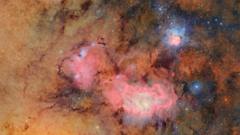The Vera C. Rubin Observatory in Chile has made waves with the release of its first celestial images, showcasing the striking Trifid and Lagoon nebulae, found 9,000 light years from Earth. These visuals highlight the observatory’s capacity to explore the universe like never before, leveraging its cutting-edge digital imaging technology.
Nestled in the Andes mountains, the observatory features the world's most advanced digital camera and is set to conduct a comprehensive decade-long survey of the southern sky. The telescope aims to identify potentially hazardous asteroids, search for a theoretical ninth planet within our solar system, and investigate the enigma of dark matter, which constitutes much of the cosmos.
Astrophysicist Catherine Heymans, Astronomer Royal for Scotland, expressed her excitement, stating this telescope culminates 25 years of dedication to stellar research. The UK plays a vital role in processing data from this high-caliber project, expected to expand the catalog of known solar system objects significantly.
Located on Cerro Pachón, the observatory is meticulously designed to maintain an ideal dark sky environment for optimal observations. A carefully orchestrated approach ensures that even minor disturbances, like rogue LEDs, are managed to maintain the integrity of incoming starlight.
Among the telescope’s unique engineering features is its innovative three-mirror design, which enhances light capture efficiency. Equipped with a 3,200-megapixel camera capable of achieving high-resolution images, it can visualize faint astronomical phenomena, providing insights into the early universe.
During the surveying process, images will be captured every 40 seconds, generating approximately 10 million alerts nightly for researchers globally. The Vera Rubin Observatory's capacity for repeated scanning of the same celestial regions empowers it to detect transient cosmic events and changing phenomena.
Researchers believe this telescope could address longstanding mysteries such as the existence of the elusive Planet Nine, potentially located far beyond the solar system’s known boundaries. The insights from this observatory could fuel astronomical inquiry for years, enhancing our understanding of the Milky Way and our cosmic neighborhood.
As the scientific community prepares to analyze the data, the promise of discovery looms large, with hopes that such advancements will define the future of astronomy for generations to come. "This is an endeavor of a generation," noted optical expert Guillem Megias, capturing the significance of this moment in the field of astronomy.
Nestled in the Andes mountains, the observatory features the world's most advanced digital camera and is set to conduct a comprehensive decade-long survey of the southern sky. The telescope aims to identify potentially hazardous asteroids, search for a theoretical ninth planet within our solar system, and investigate the enigma of dark matter, which constitutes much of the cosmos.
Astrophysicist Catherine Heymans, Astronomer Royal for Scotland, expressed her excitement, stating this telescope culminates 25 years of dedication to stellar research. The UK plays a vital role in processing data from this high-caliber project, expected to expand the catalog of known solar system objects significantly.
Located on Cerro Pachón, the observatory is meticulously designed to maintain an ideal dark sky environment for optimal observations. A carefully orchestrated approach ensures that even minor disturbances, like rogue LEDs, are managed to maintain the integrity of incoming starlight.
Among the telescope’s unique engineering features is its innovative three-mirror design, which enhances light capture efficiency. Equipped with a 3,200-megapixel camera capable of achieving high-resolution images, it can visualize faint astronomical phenomena, providing insights into the early universe.
During the surveying process, images will be captured every 40 seconds, generating approximately 10 million alerts nightly for researchers globally. The Vera Rubin Observatory's capacity for repeated scanning of the same celestial regions empowers it to detect transient cosmic events and changing phenomena.
Researchers believe this telescope could address longstanding mysteries such as the existence of the elusive Planet Nine, potentially located far beyond the solar system’s known boundaries. The insights from this observatory could fuel astronomical inquiry for years, enhancing our understanding of the Milky Way and our cosmic neighborhood.
As the scientific community prepares to analyze the data, the promise of discovery looms large, with hopes that such advancements will define the future of astronomy for generations to come. "This is an endeavor of a generation," noted optical expert Guillem Megias, capturing the significance of this moment in the field of astronomy.


















